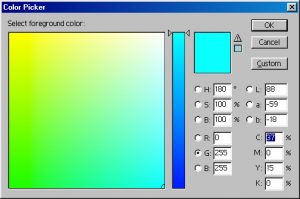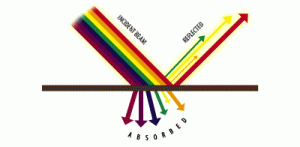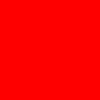색상 관리
Basic Color Theory
컬러 이미지를 정확하게 인쇄하거나 표시하는 데 있어 가장 어려운 점은 가시 스펙트럼의 모든 색상을 재현할 수 없는 기기나 기술을 사용하여 실제 세계의 색상에 근접하려고 한다는 점입니다.

가시광선 스펙트럼에는 약 400nm에서 약 700nm까지의 파장이 포함됩니다.
또한, 우리가 선택한 기술 중 일부는 다른 기술보다 더 뛰어난 기능을 제공합니다. 예를 들어, 컴퓨터 모니터는 일반적으로 잉크젯 프린터보다 실제 색상을 훨씬 더 잘 시뮬레이션합니다. 이것이 바로 컬러 관리가 필요한 이유 중 하나입니다. 색상 관리는 사용 중인 프로세스나 디바이스에서 가능한 가장 정확한 색상을 출력할 수 있도록 도와줍니다.
색상 모델
색상을 묘사하고 재현하는 데 도움이 되는 여러 가지 색상 모델 또는 색 공간이 있습니다. 이러한 색상 모델을 사용하면 물리적 표현과 숫자 값을 사용하여 색상을 지정할 수 있습니다. 다음 섹션에는 그래픽 재현에 가장 일반적으로 사용되는 색 공간이 요약되어 있습니다.
'정확한 색상'에 대한 참고 사항입니다:
'정확하다'는 것 자체가 주관적인 용어라는 것을 알게 될 것입니다. 사실 고객들은 정확한 색상을 원하지 않는 경우가 많습니다. 그들은 전시회에서 시선을 끌 수 있는 '극단적인' 또는 형광색을 원합니다. 그러나 당분간은 가능한 한 실제와 가까운 색상을 의미하는 정확도를 사용할 것입니다.
RGB 및 애디티브 컬러
RGB(빨강, 초록, 파랑) 색상 공간은 사람의 눈이 작동하는 방식과 유사합니다. TV와 컴퓨터 화면, 사진 및 기타 디지털 출력 장치에서 색상을 만드는 데 사용됩니다. 디지털 카메라와 스캐너는 RGB 공간에서 컬러 데이터를 캡처합니다.
RGB는 빛으로 "페인팅"하기 때문에 부가 색상이라고 합니다. 이 모델을 사용하는 이유는 RGB 원색의 세 가지 파장이 눈에서 뇌로 전달되는 신호와 어느 정도 일치하기 때문입니다. RGB로 표시됩니다.

RGB 원색을 혼합하면 보조 색상이 생성됩니다.
컴퓨터 모니터 기술은 RGB가 어떻게 색상을 만드는지 보여주는 좋은 예입니다. 모니터는 각 기본 색상(R, G, B)에 대해 하나씩 세 개의 전자총을 화면에 발사합니다. 세 가지를 모두 최대 강도로 혼합하면 결합된 RGB 원색이 흰색을 생성합니다.
- 빨간색과 녹색을 최대 강도로 혼합하면 노란색이 됩니다.
- 빨간색과 파란색을 최대 강도로 혼합하면 마젠타색이 됩니다.
- 파란색과 녹색을 최대 강도로 혼합하면 청록색이 됩니다.
공교롭게도 이들은 잠시 후에 설명할 또 다른 색 공간인 CMY의 기본 색상입니다.

포토샵에서 청록색 지정
RGB는 3차원 색 공간으로, 이 공간 내의 모든 색은 세 개의 숫자를 사용하여 설명할 수 있습니다. 예를 들어 시안색은 R = 0, G = 255, B = 255로 표현할 수 있습니다.
잉크젯 인쇄의 주요 과제 중 하나는 사진 이미지(예: TIFF 파일)가 일반적으로 RGB로 캡처되지만 궁극적으로 CMYK로 렌더링된다는 점입니다. 이 두 공간의 특성이 상당히 다르기 때문에 일반적으로 CMYK 인쇄 프로세스의 기능을 극대화하는 방식으로 이미지를 RGB에서 CMYK로 변환해야 합니다. 하지만 너무 앞서가기 전에 CMY(K) 색상 모델로 넘어가 보겠습니다.
포토샵에 대해 말하자면 . . .
Adobe Photoshop® 및 기타 그래픽 애플리케이션에서 RGB 원색 레벨은 0-100%의 백분율이 아닌 0-255의 범위로 표시됩니다. 세 개의 기본값이 모두 255이면 화면이 흰색이어야 합니다. 세 개의 기본값이 모두 0이면 화면이 검은색이어야 합니다. 세 가지 기본값이 모두 동일한 값으로 표시되면 화면에 중성 회색이 표시됩니다.
CMYK 및 차감 색상
시안, 마젠타, 노랑(CMY)은 잉크로 인쇄하는 대부분의 인쇄 장치에 사용되는 색상 모델(일반적으로 CMYK 형태)입니다. 여기에는 오프셋 프레스, 잉크젯 및 정전식 프린터가 포함됩니다. CMY 색 공간은 이론적으로 RGB 색 공간과 반대이지만 상호 보완적인 색 공간이기도 합니다.
원색을 더하여 새로운 색상을 만드는 대신 CMY는 흰색에서 색상을 뺍니다. 흰색은 모든 색상을 조합하여 구성됩니다. CMY 시나리오에서는 이론상 전체 스펙트럼 색상 팔레트인 흰색 종이로 시작합니다. 들어오는 빛이 종이에 반사되어 우리 눈에 다시 반사되기 때문에 흰색으로 보입니다. 종이에 잉크가 없으면 흰색이 모두 반사됩니다. 특정 색조의 잉크로 인쇄할 때 스펙트럼의 일부는 잉크에 흡수되고 나머지는 눈에 반사됩니다. 다시 말해, 각 CMY 원색은 특정 파장을 흡수하고 나머지는 우리 눈에 다시 반사하는 필터 역할을 합니다.

들어오는 빛은 CMYK 잉크로 필터링되어 흡수되지 않은 색상이 눈에 반사됩니다.
바로 이 지점에서 CMY와 RGB의 상호 보완적인 관계가 작용합니다. 아래 차트에서 볼 수 있듯이 각 CMY 원색은 RGB 원색 중 하나를 흡수하여 나머지 두 원색을 "볼 수 있게" 합니다. 시안색은 빨간색을 흡수하므로 우리가 보는 것은 파란색과 녹색이 반사된 것입니다.
| CMY 기본 | 흡수 | 반영 |
| Cyan | 빨간색 | 녹색/파란색 |
| 마젠타 | 녹색 | 빨간색/파란색 |
| 노란색 | 파란색 | 빨간색/녹색 |
CMY 및 CMYK 관련 문제
CMY 모델의 어려움 중 하나는 실제 물리적 잉크가 빛을 사용하는 RGB 프로세스보다 색상을 만드는 데 효율적이지 않다는 점입니다. 또한 일부 CMY 기본 색상(특히 시안색)은 다른 색상보다 효율성이 떨어집니다. 이러한 조건은 원자재 및 제조 공정의 변화를 비롯한 여러 가지 요인으로 인해 발생합니다. 대부분의 경우(전부는 아니지만) RGB 공간에서 색상을 생성하면 CMY로 색상을 생성하는 것보다 더 넓은 색 영역을 확보할 수 있습니다.
CMY를 사용하여 보조 색상을 혼합하기 시작하면 이를 매우 명확하게 확인할 수 있습니다. RGB 원색을 동일한 비율로 혼합했을 때 일종의 중성 회색이 나온 것을 기억하실 것입니다. 그러나 동일한 비율의 CMY를 혼합하면 중성 회색이 나오지 않습니다. 색조가 있는 회색이 표시됩니다. 중성 회색을 CMY로 인쇄하려면 시안이 마젠타색과 노란색보다 약하다는 사실을 보완해야 합니다. 예를 들어, 오프셋 인쇄의 경우 25% 중성 CMY 회색은 종종 C=25, M=17, Y=17로 지정됩니다. 이것은 CMY로 RGB 이미지 원본을 인쇄할 때 발생하는 문제에 대한 또 다른 힌트입니다.
 |
 |
|
| 동등한 회색으로 만든 값의 25% CM 및 Y |
C=25%로 만든 회색 M=17% 및 Y=17% |
CMY 잉크를 사용하여 생성하는 "RGB" 보조 색상은 "실제 RGB"로 생성하는 보다 이상적인 색상 조합과 분명히 일치하지 않습니다. 예를 들어 마젠타색과 노란색 잉크를 혼합하여 만든 빨간색은 컬러 모니터의 빨간색 기본 색상과 일치하지 않습니다. 그러나 색상 보정 및 색상 관리 방법을 사용하여 결과를 개선할 수 있습니다.
 |
 |
|
| 이 "RGB" 빨간색은 R=255,G=0 및 B=0 |
이 "CMY" 빨간색은 C=0입니다, M=100% 및 Y=100% |
CMYK의 "K"
마지막으로 세 가지 CMY 원색을 각각 100%로 혼합하면 순수한 검정색이 나와야 하지만 실제로는 그렇지 않습니다. 갈색을 띤 회색이 됩니다. 이 때문에 인쇄 프로세스에 "K"로 표시되는 검정 잉크가 추가되었습니다. CMY 조합으로는 처리할 수 없는 깊은 그림자 영역을 렌더링하려면 "진짜" 검은색이 필요합니다. 또한 "실제" 검은색 텍스트와 선화를 인쇄하려면 K가 필요합니다. K 채널은 CM 및 Y와 결합하여 CMYK 색 공간을 완성합니다.
다시 한 번, 4차원 CMYK 색상 공간에서 색상을 설명하기 위해 일련의 네 가지 숫자를 사용할 수 있으며, 각 숫자는 원색의 백분율입니다. 아래 표시된 주황색은 C=0, M=64, Y=86으로 표시됩니다. 이러한 수치적 사양은 색상을 설명하는 유용한 방법이지만 여전히 상대적인 것입니다. CMY 잉크의 색상은 매우 다양하므로 서로 다른 브랜드의 동일한 비율을 혼합하여 다양한 보조 색상을 생성할 수 있으며 경우에 따라 동일한 브랜드의 다른 배치를 혼합하여 다양한 보조 색상을 생성할 수 있습니다.
RGB 색상 모델을 사용하는 디바이스는 일반적으로 CMYK를 사용하는 디바이스보다 색 영역이 더 넓지만, 추가 K 채널은 인쇄 이미지의 톤 범위를 제어하는 데 상당한 유연성을 제공합니다. 블랙 채널의 동작을 이해하고 제어하는 것은 이미지 품질 관리의 주요 이점입니다.
CMYK 그 이상의 잉크
지난 몇 년 동안 기본 CMYK에 다른 원색을 추가하는 하이파이 및 확장 가멋 잉크젯 프린터가 출시되었습니다. 이 프로세스는 주황색과 녹색이 추가되면서 시작되었으며, 최신 패브릭 프린터에서는 파란색과 빨간색, 청록색 또는 별색과 같은 다른 옵션도 제공합니다.

이 주황색은 C=0, M=64, Y=86으로 지정되어 있지만 잉크젯 프린터에서 인쇄할 때와 오프셋 프레스에서 인쇄할 때는 동일하게 보이지 않습니다. 실제로 색상 관리를 적용하지 않으면 다른 잉크젯 장치에서 인쇄할 때에도 다르게 보일 수 있습니다.
결론
이러한 다양한 잉크와 출력 장치를 모두 처리하기 위해 실제로 필요한 것은 숫자 색상 설명 값이 보편적인 표준 색상 모델입니다. 그런 것이 있으며 와사치는 실용적인 방식으로 매우 쉽게 적용 할 수 있습니다.
이것은 Wasatch SoftRIP 사용자에게 무엇을 의미합니까?
이것은 흥미롭지만 SoftRIP에서 훌륭한 결과를 얻기 위해 이 기능을 알 필요는 없을 것입니다. 디지털 색상 과학 및 재현에 대해 가능한 한 많이 아는 것이 유리하지만, SoftRIP는 거의 모든 수준의 사용자 지식에 맞게 조정할 수 있도록 설계되었습니다. 와사치는 ICC 워크플로우, 별색 교체 및 하이파이 색상 구성을 위한 매우 정교한 제어 기능을 제공하지만 기본 제어 기능을 사용하여 매일 훌륭한 상업용 인쇄물을 제작할 수 있습니다.
Adobe 및 Adobe Photoshop은 미국 및 기타 국가에서 Adobe Systems Incorporated의 등록 상표 또는 상표입니다.
기타 모든 상표는 해당 소유자의 자산입니다.
